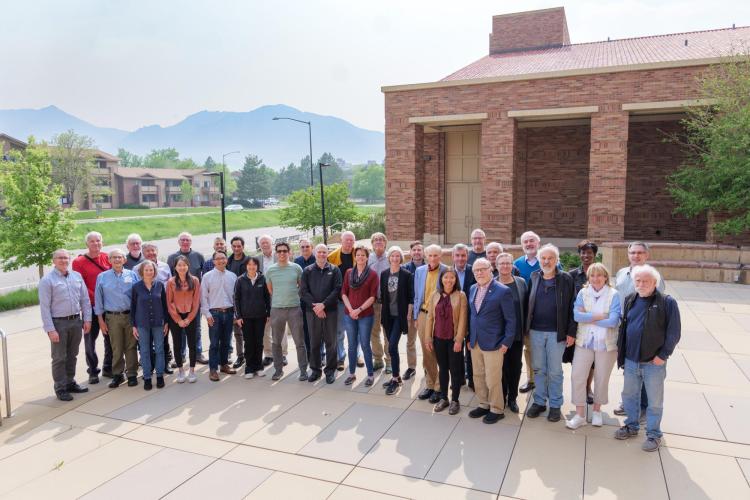Jennifer Doudna still remembers a moment that changed how she viewed her responsibilities as a scientist.
Doudna, a professor of biochemistry at the University of California, Berkeley, was sitting in her office in 2014 when she opened a scientific article by a team of Chinese researchers. The group had used a technology called CRISPR/Cas9 to edit the genetic code of embryos taken from captive macaques in a lab. Those embryos could now grow into baby monkeys who might, eventually, pass their edited genomes to their own offspring. And on and on for generations.
Technically, there was no reason this couldn't also be done in humans, she thought to herself.
"I realized that I needed to start speaking out about the real risks and challenges of this very, very powerful technology," explained Doudna before a rapt crowd of hundreds at Macky Auditorium on the CU Boulder campus Tuesday evening.
Those risks, and also the promises, of CRISPR formed the crux of the public event, "The Future and Ethics of Genome Editing," which was sponsored by the BioFrontiers Institute.
In 2012, Doudna and French microbiologist Emmanuelle Charpentier published a landmark paper that helped pioneer this approach to gene editing. Like a cellular tweezer, CRISPR/Cas9 can pluck out and replace snippets of DNA from the chromosomes of almost any organism on the planet. The discovery earned the duo a Nobel Prize in Chemistry in 2020.
Doudna joined several luminaries in the fields of biology, chemistry, medicine and more for the talk and panel discussion. They included Jason Chin of the University of Cambridge; Tracy Johnson of the University of California, Los Angeles; Eric Olson of the University of Texas Southwestern Medical Center; and Özlem Türeci, co-founder of the company BioNTech. Nobel Laureate Thomas Cech, a distinguished professor of biochemistry at CU Boulder, moderated the discussion.
Panelists dove into the possible future of gene editing tools-from curing illnesses like sickle cell disease to the potential for parents to create their own designer children. CRISPR could even, Doudna explained, help scientists clean up cow burps, a surprising contributor of greenhouse gases to the atmosphere.
"The technology continues to advance incredibly quickly, and it's very exciting," Doudna said from the stage. "We don't want to slow down the science, but we certainly want to make sure that it's used in a responsible fashion going forward."
Extraordinary moments
In an emotional moment, the biochemist, who spent three years working as a postdoctoral researcher at CU Boulder in the 1990s, spoke about meeting Victoria Gray. Gray lives in Mississippi and was one of thousands of Americans who contend with sickle cell disease, an often-debilitating illness that affects red blood cells. But in 2019, she also became the first person in the United States to be cured of this disease-completely. The process involved removing some of Gray's stem cells, editing them in the lab using CRISPR, then returning them to her body through a procedure similar to a bone marrow transplant.
"For me as a scientist, this was really one of the most extraordinary moments of my life and my career," Doudna said. "She told me that it truly transformed her life."
She and her fellow panelists highlighted other potential benefits of CRISPR. Doudna noted that a team of scientists from California is exploring how CRISPR could rewrite the genomes of bacteria living in cow guts-potentially reducing how much methane, a potent greenhouse gas, those animals churn out as they munch on grass or feed.
But the speakers also acknowledged that gene editing tools come with concerns.
Olson explained that CRISPR is remarkably accurate but still produces rare errors. Depending on how it is used, those errors could potentially wind up in the genetic continuity, or "germ line," of humans and other organisms. For these reasons, scientists have agreed not to pursue germ-line editing at this time.
"The germ line is like a river of DNA that flows into the future, and if a mistake is introduced into that river, it can't be retrieved," said Olson, who explores the potential of CRISPR to cure a disease called Duchenne muscular dystrophy.
Future paths
During a question-and-answer session, audience members asked the panelists if parents could use CRISPR to engineer, for example, tall children. The answer: It's not impossible, but it would be very difficult.
One audience member also brought up concerns raised by members of the disability community. Some advocates worry that scientists could use CRISPR to eliminate certain genetic conditions, like intellectual disabilities, from the human race entirely.
In response, Johnson posed a question: "Whose right is it to make a decision about a child before they reach the age of being able to experience what their life would be like [with a disability]?"
"There isn't a good answer right now," she said. "But I think there's going to be a lot of really important debate."
In the end, the panelists urged governments to work with scientists, ethicists and others to hash out the uses and limits of gene editing tools. Cech, meanwhile, was glad that so many people showed up to hear from the panelists in person.
"It's good to have the public here because they need to be part of this discussion," he said at Macky. "And they will have an enormous range of views."









